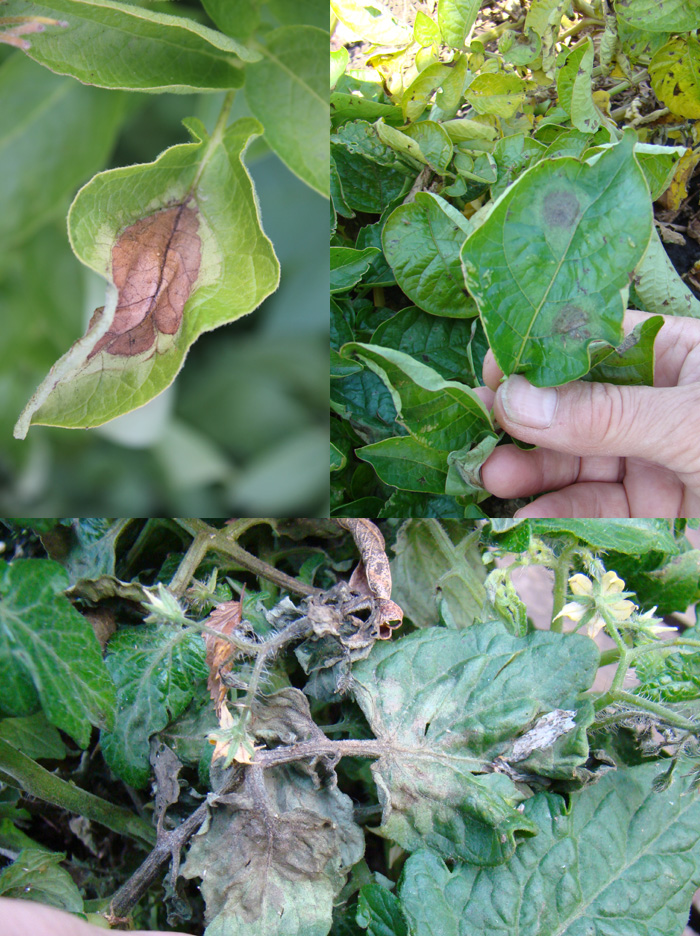
Late blight
Phytopthora infestans
Late blight (Phytophthora infestans) affects potatoes and other solanaceous crops like tomato. It may also affect eggplant and peppers. While late blight is not as common in Saskatchewan as early blight, it is a much more devastating disease when it does occur. Late blight is the same disease that destroyed potato crops that caused the Irish Potato Famine of 1845 - 1852.
Late blight has been a relatively rare problem in Saskatchewan because of our typically hot, dry summers. However, there is a trend to more frequent, sustained periods of rain in the summer along with cooler summertime temperatures as a result of climate change. Conditions were right in the summer of 2010 in Saskatchewan for a severe outbreak of late blight.
The ideal conditions for late blight are:
- Cool daytime temperatures of 15°C - 21°C , dropping to 10°C - 15°C at night.
- Windy conditions to spread the fungal spores.
- Wet conditions (relative humidity above 90%).
- The presence of the fungal spores. The fungus cannot survive winter, and typically blows in from the south.
Symptoms:
- Lesions appear on older leaves following several days of warm (13°C) and wet or humid weather.
- Late blight lesions begin as dark green, water-soaked areas at the leaf tips. A yellowish-white halo will often surround these lesions. The lesions grow rapidly and do not stop at the leaf veins.
- A white fungal growth can sometimes be detected on the underside of infected leaves, especially on dewy mornings.
- Under wet, warm conditions, late blight spreads rapidly and can kill an entire potato patch in a few days.
- Tubers at or near the soil surface will be infected by late blight spores. Tubers infected with late blight display sunken lesions (especially around the eyes) that become reddish and granular.
- Soft rot bacteria quickly invade late blight damaged tubers, turning the entire potato storage into a mushy, rotting, bad-smelling mess.
Control:
- Potato plant foliage infected by late blight should be immediately removed from the garden and frozen (to kill the fungus). Tubers not affected by rot can be eaten.
- Examine the tubers for signs of infection and cull the bad ones. Infected tubers culled from the crop should be frozen and disposed of in the garbage. If more than 5% of tubers are infected refrain from long term storage as the fungus will spread and cause tubers to rot.
- Late blight can only overwinter on the Canadian prairies in living potatoes. Never plant stored potato tubers that are suspected of carrying late blight.
- Only use certified disease-free potato seed. Space seeds properly to avoid overcrowding.
- Do not grow potatoes or tomatoes in a wet, low-lying area of the garden. Avoid overhead watering if possible. If not, water early in the day to give leaves a chance to dry off.
- Keep hilling potatoes as deep tubers are less likely to get infected.
- There have been incidences of greenhouse-grown tomato transplants spreading the late blight fungus early in spring: ensure that your tomato transplants are grown by a reputable greenhouse grower.
- Late blight is one of the most studied fungal diseases of vegetables in the world. Research has shown that the disease has become resistant to certain fungicides.
- Studies also show that too much nitrate nitrogen and high concentrations of potassium increase the severity of the disease.
- Potato cultivar sensitivity to late blight:
- Sensitive: all red-skinned potatoes, Shepody
- Moderately sensitive: Norkotah, Burbank, Yukon Gold
- Tough: Alpine, Classic, Milva, Yukon Gem
- No cultivar is immune to late blight
- Tomato cultivar sensitivity to late blight:
- Some resistance: Juliet, Santa, Legend and Defiant

